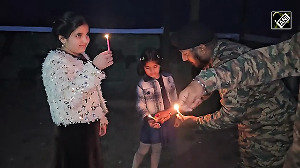Seven members of the Central Reserve Police Force and one civilian were killed in the early hours of January 1 when a group of four unidentified terrorists, armed with AK-47 rifles and hand-grenades, attacked a CRPF camp at Rampur in Uttar Pradesh.
According to Brij Lal, Additional Director-General of Police (law and order), the terrorists opened fire killing two CRPF men and hurled grenades while entering the camp. In the firing inside the premises, five CRPF jawans, who were sleeping, were killed.
Since March, 1993, there have been periodic incidents of jihadi terrorism in Indian territory outside Jammu and Kashmir. While the majority of these incidents involved the use of improvised explosive devices and were directed at civilians and other soft targets, there have also been instances of attacks on security forces personnel with hand-held weapons. Examples: The attacks on Indian Parliament in New Delhi in December 2001; on the security guards outside the US Consulate in Kolkata in January, 2002; on the Akshardam Temple in Ahmedabad in September, 2002; at Ayodhya in Uttar Pradesh in July, 2005 and on scientists attending a conference in Bangalore in December, 2005.
The Rampur attack was on a well-protected hard target of a central police force and avoided indiscriminate killing of civilians. The attack seems to have been well-planned and executed with the objective of achieving maximum public impact with minimum civilian casualties.
On November 23 last year, 13 persons were killed in seven well-synchronised attacks with IEDs near courts in three different cities of Uttar Pradesh -- Lucknow, Varanasi and Faizabad. An e-mail received by some sections of the media coinciding with the attacks claimed responsibility for the attacks as well as for some of the previous incidents of terrorism in different parts of India on behalf of what it described as 'Indian mujahideen'. The e-mail said: "We are not any foreign mujahideen. We are purely Indian." It warned: "Our next target will be the Indian police."
The UP police have since reportedly detained some youth on suspicion of having been involved in these explosions. They have been described as members of the Harkat-ul-Jihad-al-Islami (HuJI). The HuJI has its headquarters in Pakistan and an active branch in Bangladesh. In the past too, the HuJI had been involved in terrorist strikes in different parts of India. The dramatis personae came from Pakistan and/or Bangladesh with some Indian involvement.
From the indications available so far, the November strikes in UP appear to have been carried out by Indian cells of the HuJI. If this is proved by further investigation, the HuJI possibly now has an Indian branch with operatives, capable of carrying out terrorist strikes autonomously without too much dependence on their counterparts in Pakistan and Bangladesh.
There is a possibility that the Rampur strike might have also been carried out by the same organisation. If so, the fact that the arrests made by the UP police during the investigation of the November 23 strikes did not disrupt or prevent the attack at Rampur, would indicate that the organisation has a wider network of clandestine cells in UP than detected so far.





